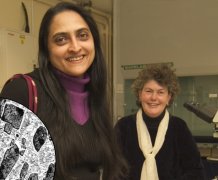
Dr Sharada Srinivasan (NIAS, Bangalore) and Dr Gill Juleff (Exeter) - research collaborators in ancient Indian metallurgy.
Humanities strengthens links with India at Royal Society seminar
On 7-9 March, the Archaeology Department is hosting a 3-day Scientific Seminar, funded through the Royal Society’s India-UK Scientific Seminar scheme, for a small group of early and mid-career archaeometallurgists and archaeologists from UK and India to explore developing interdisciplinary applications in archaeometallurgy and geospatial archaeology.
The seminar, 'Royal Society India-UK Scientific Seminar in Indian iron and steel – developing interdisciplinary applications in archaeometallurgy and geospatial archaeology', arises from the research links established between the Archaeology Department at Exeter and the National Institute of Advanced Studies (NIAS) in Bangalore.
Over three years a team of Exeter-NIAS researchers, in a UKIERI-funded project entitled oldprojects, have been using a wide range of techniques to study the archaeology and landscape of northern Andhra Pradesh where iron and high-quality steel were produced in ancient times. The steel of this region was made in purpose-designed crucibles and was exported across India and to the Islamic world for the manufacture of swords, including the fabled swords of Damascus.
This seminar will bring together a small group of researchers from India and the UK who are engaged in diverse disciplines within archaeology, from GIS-based and remote-sensing techniques to material culture studies and microstructural analyses of metals and associated materials. The aim is to share experience and explore synergies that could form the foundations of future research collaborations.
The UK participants in the seminar include Exeter staff and past postgraduates as well as researchers from other UK universities. The Indian invitees represent NIAS and the University of Baroda.
Humanities at Exeter is building international partnerships with Bangalore and this seminar reflects the strong bond that has been created with NIAS. It also demonstrates the central role of scientific research in archaeology and bridges the gap between humanities and science.
Date: 28 February 2012
